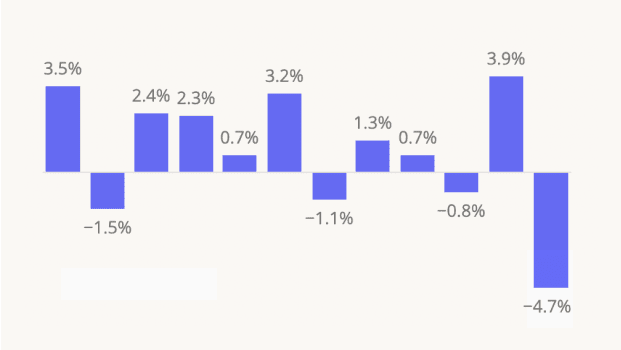Insights into the physical world anchored in location analytics
Article

Article
Placer.ai Mall Index: Traffic Up Across All Mall Formats The Kroger Co, is a leading player in the grocery store space, operating its epon lorem ipsum dolor sit amet, consectetur adipiscing elit, sed do eiusmod tempor incididunt ut labore et dolore magna aliqua. Ut enim ad minim veniam, quis nostrud exercitation ullamco laboris nisi ut aliquip ex ea commodo consequat. Duis aute irure dolor in reprehenderit in voluptate velit esse cillum dolore eu
May 7, 2025
4 minutes

INSIDER
Report
Domestic Migration in 2025: The Great SlowdownDive into the data to explore domestic migration patterns over the past four years – and uncover states and metro areas emerging as relocation hotspots in 2025.
April 25, 2025
6 minutes
Article
Article
First Watch Traffic Continues to Climb The Kroger Co, is a leading player in the grocery store space, operating its epon lorem ipsum dolor sit amet, consectetur adipiscing elit, sed do eiusmod tempor incididunt ut labore et dolore magna aliqua. Ut enim ad minim veniam, quis nostrud exercitation ullamco laboris nisi ut aliquip ex ea commodo consequat. Duis aute irure dolor in reprehenderit in voluptate velit esse cillum dolore eu
May 5, 2025
1 minute
Article
Article
Warby Parker and Allbirds: Stabilization Trends Into 2025The Kroger Co, is a leading player in the grocery store space, operating its epon lorem ipsum dolor sit amet, consectetur adipiscing elit, sed do eiusmod tempor incididunt ut labore et dolore magna aliqua. Ut enim ad minim veniam, quis nostrud exercitation ullamco laboris nisi ut aliquip ex ea commodo consequat. Duis aute irure dolor in reprehenderit in voluptate velit esse cillum dolore eu
May 5, 2025
3 minutes
Industry Trends
Year-Over-Year Visits to Grocery Stores by State
Executive Insights

Executive Insights
The Untapped Potential of Class-B Malls The Kroger Co, is a leading player in the grocery store space, operating its epon lorem ipsum dolor sit amet, consectetur adipiscing elit, sed do eiusmod tempor incididunt ut labore et dolore magna aliqua. Ut enim ad minim veniam, quis nostrud exercitation ullamco laboris nisi ut aliquip ex ea commodo consequat. Duis aute irure dolor in reprehenderit in voluptate velit esse cillum dolore eu
May 6, 2025
4 minutes
Article

Article
Placer.ai Mall Index: Traffic Up Across All Mall Formats The Kroger Co, is a leading player in the grocery store space, operating its epon lorem ipsum dolor sit amet, consectetur adipiscing elit, sed do eiusmod tempor incididunt ut labore et dolore magna aliqua. Ut enim ad minim veniam, quis nostrud exercitation ullamco laboris nisi ut aliquip ex ea commodo consequat. Duis aute irure dolor in reprehenderit in voluptate velit esse cillum dolore eu
May 7, 2025
4 minutes
Executive Insights

Executive Insights
The Untapped Potential of Class-B Malls The Kroger Co, is a leading player in the grocery store space, operating its epon lorem ipsum dolor sit amet, consectetur adipiscing elit, sed do eiusmod tempor incididunt ut labore et dolore magna aliqua. Ut enim ad minim veniam, quis nostrud exercitation ullamco laboris nisi ut aliquip ex ea commodo consequat. Duis aute irure dolor in reprehenderit in voluptate velit esse cillum dolore eu
May 6, 2025
4 minutes
Article

Article
First Watch Traffic Continues to Climb The Kroger Co, is a leading player in the grocery store space, operating its epon lorem ipsum dolor sit amet, consectetur adipiscing elit, sed do eiusmod tempor incididunt ut labore et dolore magna aliqua. Ut enim ad minim veniam, quis nostrud exercitation ullamco laboris nisi ut aliquip ex ea commodo consequat. Duis aute irure dolor in reprehenderit in voluptate velit esse cillum dolore eu
May 5, 2025
1 minute
Article

Article
Warby Parker and Allbirds: Stabilization Trends Into 2025The Kroger Co, is a leading player in the grocery store space, operating its epon lorem ipsum dolor sit amet, consectetur adipiscing elit, sed do eiusmod tempor incididunt ut labore et dolore magna aliqua. Ut enim ad minim veniam, quis nostrud exercitation ullamco laboris nisi ut aliquip ex ea commodo consequat. Duis aute irure dolor in reprehenderit in voluptate velit esse cillum dolore eu
May 5, 2025
3 minutes

Latest

Article
Resilience 5 Years Post-Covid: Spotlight on Victoria Gardens in Rancho Cucamonga, CAWe analyzed traffic data for one of the most-visited open-air shopping centers in the nation, Victoria Gardens, to see what sets it apart and what continues to draw consumers to open-air centers.
May 2, 2025
3 minutes

Article
Aldi & Lidl's Winning FormulaA strong value proposition has never been more important to shoppers – and discount powerhouses like Aldi and Lidl are prime examples. We took a closer look at some of the location intelligence to see where the two grocers stand.
May 1, 2025
4 minutes

Article
Self-Storage: Resilience in 2025Amid rising housing costs and shifting consumer lifestyles, self-storage has emerged as a go-to solution for many Americans. We dove into the data to take the pulse of the market in Q1 2025 – and uncover the audience segments behind the industry’s ongoing growth.
April 30, 2025
3 minutes

Article
Love in the Time of BookstoresWe took a look at a Brooklyn-based romance bookstore – The Ripped Bodice – to see what visitation trends reveal about the value of specialty stores in an environment increasingly dominated by general retailers.
April 29, 2025
4 minutes

Article
Dutch Bros Gains, But Starbucks Holds Top SpotVisits to coffee chains like Starbucks, Dunkin,’ and Dutch Bros have been on the rise recently - and smaller coffee chains like Scooters Coffee and 7 Brew are also thriving. We took a look at Q1 2025 traffic to see how the segment is faring.
April 28, 2025
3 minutes

Article
CAVA and sweetgreen Take to the SuburbsCAVA and sweetgreen are cementing their place as leaders in the fast-casual space. The two chains have seen impressive growth over the past few years, adding new locations to keep up with growing demand. We took a look at their performance over the years to see what might be driving their continued rise.
April 25, 2025
3 minutes

Article
Sinners Fuels Movie Theater Momentum The release of Sinners kept movie theater visits high following the momentum generated from A Minecraft Movie.
April 25, 2025
1 minute

Article
The Impact of QSR Promotions in Q1 2025Using the latest location intelligence, we analyzed RBI, Yum! Brands, and other top QSRs, to explore their Q1 2025 performance and several promotions that had a significant foot traffic impact.
April 24, 2025
3 minutes

Article
Health-Centric Grocers Lead the Way We dive into the visit data for Sprouts Farmers Market and Natural Grocers to see how the two health-centric grocers are performing in Q1 2025.
April 23, 2025
3 minutes

Article
Crafting a Goodbye: What Location Analytics Reveals About JOANN’s DepartureFollowing a second bankruptcy filing, JOANN recently announced a complete shutdown of its fleet. Using location analytics, we uncovered the foot traffic trends behind JOANN’s unraveling and pinpointed retailers that stand to gain from its exit from the arts and crafts space.
April 22, 2025
3 minutes

Article
What Visitation Data Reveals About Industrial Manufacturing Demand Ahead of TariffsVisitation data at manufacturing facilities can shed light on consumer demand and industrial output trends. We dove into the traffic data at a composite of manufacturing facilities across the United States to find out how the potential tariffs are impacting manufacturing output.
April 22, 2025
4 minutes

Executive Insights
All The Things I Think I Think About Retail Over The Last QuarterFind out all the thoughts Chris Walton has had about retail throughout Q1 2025. Which brands are thriving, which are poised for a turnaround, and who may be on the decline?
April 21, 2025
13 minutes
Retail




Article
Warby Parker and Allbirds: Stabilization Trends Into 2025Direct-to-consumer retailers Warby Parker and Allbirds have taken different approaches to their brick-and-mortar stores - Warby Parker has been expanding while Allbirds has shrunk its store fleet. How are the two retailers faring thus far into 2025? We took a closer look.
May 5, 2025
3 minutes

Article
Aldi & Lidl's Winning FormulaA strong value proposition has never been more important to shoppers – and discount powerhouses like Aldi and Lidl are prime examples. We took a closer look at some of the location intelligence to see where the two grocers stand.
May 1, 2025
4 minutes

Article
Love in the Time of BookstoresWe took a look at a Brooklyn-based romance bookstore – The Ripped Bodice – to see what visitation trends reveal about the value of specialty stores in an environment increasingly dominated by general retailers.
April 29, 2025
4 minutes

Article
Health-Centric Grocers Lead the Way We dive into the visit data for Sprouts Farmers Market and Natural Grocers to see how the two health-centric grocers are performing in Q1 2025.
April 23, 2025
3 minutes
QSR




Article
First Watch Traffic Continues to Climb First Watch is continuing to add more stores to its fleet, and visits continue to grow as well.
May 5, 2025
1 minute

Article
Dutch Bros Gains, But Starbucks Holds Top SpotVisits to coffee chains like Starbucks, Dunkin,’ and Dutch Bros have been on the rise recently - and smaller coffee chains like Scooters Coffee and 7 Brew are also thriving. We took a look at Q1 2025 traffic to see how the segment is faring.
April 28, 2025
3 minutes

Article
The Impact of QSR Promotions in Q1 2025Using the latest location intelligence, we analyzed RBI, Yum! Brands, and other top QSRs, to explore their Q1 2025 performance and several promotions that had a significant foot traffic impact.
April 24, 2025
3 minutes

Executive Insights
All The Things I Think I Think About Retail Over The Last QuarterFind out all the thoughts Chris Walton has had about retail throughout Q1 2025. Which brands are thriving, which are poised for a turnaround, and who may be on the decline?
April 21, 2025
13 minutes




.png)
.png)

.png)
.png)












.svg)